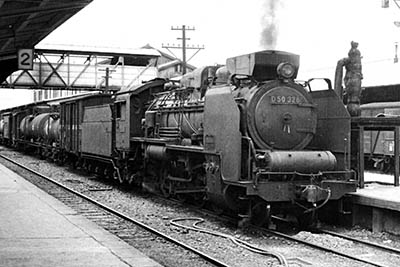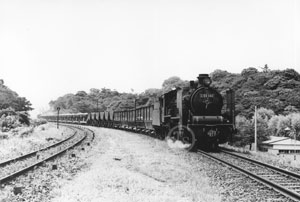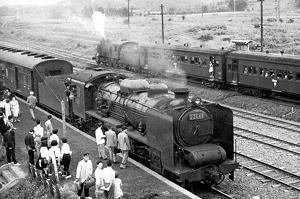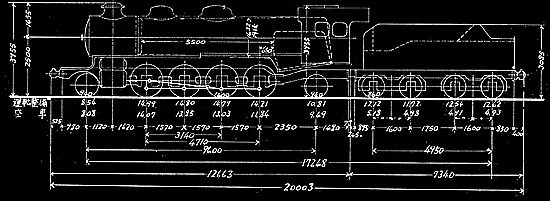
D50 No.328
Matsumoto, Shinonoi line during Apr.1959.
(Photo credit to S.Sumino)
Japanese
|
1923 - 1971 (1972) A middle to large Tender-Engine for main and sub-main line freight trains. |

D50 No.328 Matsumoto, Shinonoi line during Apr.1959. (Photo credit to S.Sumino) |
|
The D50 was the result of a need for a more powerful freight model than the class 9600.
D50's horse power was increased spectacularly by about 50% to 1,280HP from the 9600's 870 HP.
This is worthy of special mention in regard to Japanese steam locomotive history.
In those days, the 9600 hauled 600 tons of freight on the Tokaido line,
but the D50 increased that amount by 350 tons or a total of 950 tons with the use of the Auto - coupler.
The first D50 was manufactured at the Kawasaki Sharyo Co. it's manufactured number was 898 during July 1923 as a class 9900 No.9900. She was retired and scrapped during Sept 1955. Between 1923 and 1928, a total of 276 were manufactured as class 9900 No.9900 - 29975. They were renamed class D50 No.1 - 276 from the class name revised in 1928. A total of 380 D50's were produced during a 9 year period. And manufacturing ceased during 1931 due to an economic downturn. After its appearance, D50 was used as an arterial line freight train. And on the Tokaido line, Hakone pass, they were used for banker. Therefore, Hakone pass's four-cylinder old model 9850 was replaced by the D50. (No.9856 is preserved at the Railway Museum in Saitama). And D50's growth was not only limited to arterial lines, but also used on main line freight trains. During 1936, the new heir model D51 came into being and the D50 was moved to sub-main lines. Only one engine, D50_193 was moved out to China during 1934, with 1435mm gauge conversion. She never returned back to Japan again. After the war, many freight engines became surplus. D50 was no exception in regard to that surplus. Therefore, an attempt was made to convert the D50 to more light grade lines. According to this plan, seventy-eight D50's were altered with a relieved axle load (2-8-2 to 2-8-4), during the years of 1951 through 1956. And they were called the class D60. The rest of the D50's were active on sub-main lines throughout all of the country. But their weeding out began relatively early because of heavy axle load and old age. 28 were retired because of war-damage or poor condition up to 1950. And weeding out was accelerated due to the more modern engine D51s surplus during 1955. D50s were decreased to about 168 during 1960. 5 years later, during 1965, the number was decreased to 87, and was decreased to 21 during 1967. Finally the last three D50's were the D50_90, 140 and 205. They survived on the Chikuho line, at the Wakamatsu depot. And they were retired during 1971. (irregular service continued until Sept. 1972 by D50_140). |
| Primary ran line in last 10 years |
Muroran, Ofunato, Nippo, and Chikuho line
| Last line/depot and year |
Chikuho line / Wakamatsu depot 1971 (irregular service continued until Sept 1972)
| Restored engine (2017) |
none
| Preserved engine (2017) |
2 (No.25, 140)
| |

|

| ||||
|
Here we see a Class D50 No.140 pulling a long trailing line of coal cars on the Chikuho line in 1970. (Photo in T.S. possession) |
We see the Class D50 at Wakamatsu depot on its last day of service on April 30,1971. A head board is displayed on the engine with the words...Sayonara...Goodbye D50. This D50_140 after it was moved to Umekoji museum. (Photo in T.S. possession)
| 
| 
D50_49 at Numanosawa Yubari line | The right old engine is probably a class 8100, ex-No.8106 or 8118, on the Mayachi Coal Line Co. Jul. 1959 (Photo credit to S.Sumino)
D50_257 (right) and | class C59 No.182 (left) at Koriyama depot. Mar.1960 (Photo credit to S.Sumino) |

| Configuration | 2-8-2 | Dimensions Length (mm) | 20003 |
| Engine Weight (Operating tons) | 78.1 | Driver size (mm diameter) | 1400 |
| Boiler pressure (Kg/cm2) | 13.0 | Max Tractive effort (tons) | 14.7 |
| Driver Max Power (PS) | 1280 | Max Speed (km/h) | 75 |
| Manufactured years | 1923-1937 | Total production | 380 |
| Number of moved out to other countries in WW2 with gauge remodeling. | 1 (No.193) | Remodeling | 78 -> class 2-8-4 D60 1951-1955 |
| Gauge | 3ft 6in (1067mm) |
Introduction |
Go to Top |